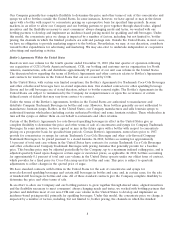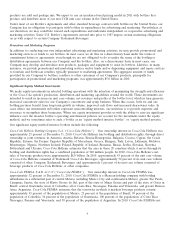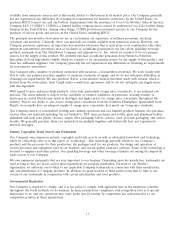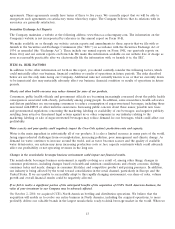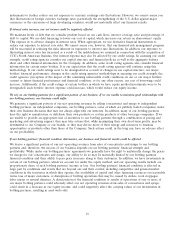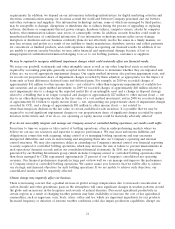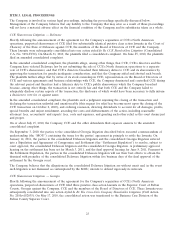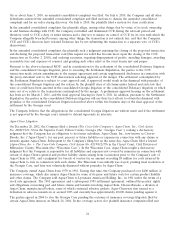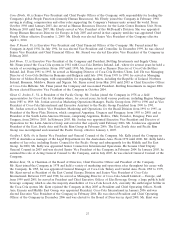Coca Cola 2010 Annual Report Download - page 20
Download and view the complete annual report
Please find page 20 of the 2010 Coca Cola annual report below. You can navigate through the pages in the report by either clicking on the pages listed below, or by using the keyword search tool below to find specific information within the annual report.Increase in the cost, disruption of supply or shortage of ingredients or packaging materials could harm our business.
We and our bottling partners use various ingredients in our business, including HFCS, sucrose, aspartame, saccharin,
acesulfame potassium, sucralose, ascorbic acid, citric acid, phosphoric acid and orange and other fruit juice
concentrates, as well as packaging materials such as PET for bottles and aluminum for cans. The prices for these
ingredients and packaging materials fluctuate depending on market conditions. Substantial increases in the prices of our
or our bottling partners’ ingredients and packaging materials, to the extent they cannot be recouped through increases
in the prices of finished beverage products, would increase our and the Coca-Cola system’s operating costs and could
reduce our profitability. Increases in the prices of our finished products resulting from higher ingredient and packaging
material costs could affect affordability in some markets and reduce Coca-Cola system sales. In addition, some of these
ingredients, such as aspartame, acesulfame potassium, sucralose, saccharin and ascorbic acid, as well as some of the
packaging containers, such as aluminum cans, are available from a limited number of suppliers, some of which are
located in countries experiencing political or other risks. We cannot assure you that we and our bottling partners will be
able to maintain favorable arrangements and relationships with these suppliers. An increase in the cost, a sustained
interruption in the supply, or a shortage of some of these ingredients, packaging materials or cans and other containers
that may be caused by a deterioration of our or our bottling partners’ relationships with suppliers; by supplier quality
and reliability issues; or by events such as natural disasters, power outages, labor strikes, political uncertainties or
governmental instability, or the like, could negatively impact our net revenues and profits. Because manufacturing and
bottling operations are heavy users of ingredients and packaging materials, our Company’s direct exposure to the risk of
an increase in the cost, disruption of supply or shortage of ingredients or packaging materials has increased as a result
of our acquisition of CCE’s North American business.
Changes in laws and regulations relating to beverage containers and packaging could increase our costs and reduce demand for
our products.
We and our bottlers currently offer nonrefillable, recyclable containers in the United States and in various other
markets around the world. Legal requirements have been enacted in various jurisdictions in the United States and
overseas requiring that deposits or certain ecotaxes or fees be charged for the sale, marketing and use of certain
nonrefillable beverage containers. Other proposals relating to beverage container deposits, recycling, ecotax and/or
product stewardship have been introduced in various jurisdictions in the United States and overseas, and we anticipate
that similar legislation or regulations may be proposed in the future at local, state and federal levels, both in the United
States and elsewhere. Consumers’ increased concerns and changing attitudes about solid waste streams and
environmental responsibility and related publicity could result in the adoption of such legislation or regulations. If these
types of requirements are adopted and implemented on a large scale in any of the major markets in which we operate,
they could affect our costs or require changes in our distribution model, which could reduce our net operating revenues
or profitability.
Significant additional labeling or warning requirements may inhibit sales of affected products.
Various jurisdictions may seek to adopt significant additional product labeling or warning requirements relating to the
content or perceived adverse health consequences of certain of our products. If these types of requirements become
applicable to one or more of our major products under current or future environmental or health laws or regulations,
they may inhibit sales of such products. One such law, which is in effect in California and is generally known as
Proposition 65, requires that a warning appear on any product sold in California that contains a substance that, in the
view of the state, causes cancer or birth defects. The state maintains lists of these substances. This law exposes all food
and beverage producers to the possibility of having to provide warnings on their products in California because it
recognizes no generally applicable quantitative thresholds below which a warning is not required. Consequently, the
detection of even a trace amount of a listed substance can subject an affected product to the requirement of a warning
label. One or more substances that are currently on the Proposition 65 lists, or that may be added in the future, can be
detected in Company products at low levels that are safe. However, Proposition 65 does not require a warning if the
manufacturer of a product can demonstrate that the use of the product in question exposes consumers to a daily
quantity of a listed substance that is below a ‘‘safe harbor’’ threshold that may be established, is naturally occurring, is
the result of necessary cooking, or is subject to another applicable exception. One of the two listed substances that can
presently be detected in a Company product has been shown to be naturally occurring. As to the other, the state has
proposed, but not yet finally established, an inappropriately low safe harbor level that is still subject to public comment
18


